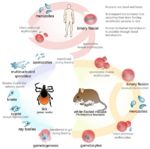- Infects a wide range of host species in different areas of the world
- Babesiosis has severe effects on cattle production in parts of the world
- Prevents European breeds from being successful in tropical regions where ticks are endemic.
- Occurs sporadically in the UK and Ireland causing losses of around £8 million per year
Life Cycle
- Both trans-stadial and trans-ovarian transmission occurs
- Each female tick produces 3000 eggs
- The tick is the definitive host
- Babesia multiplies in the red blood cells by budding
- Forms 2-4 daughter cells (species dependent)
- Giemsa blood smears can differentiate between species using 'Difquik' stain
- Babesia species are either small or large depending on the size of the daughter cells
- Small Babesia
- E.g. B. divergens
- E.g. B. gibsoni
- Peripheral nucleus
- Obtuse angle
- Large Babesia
- E.g. B. major
- E.g. B. canis-complex
- Central nucleus
- Acute angle
- Daughter cells disrupt the red blood cell and are released
- Spread and infect other red blood cells
- Antigen is released which adsorbs onto other red blood cells
- Causes haemolysis and haemoglobin pigmentation
- Causes haemolytic anaemia, haemoglobinuria and fever
Enzootic Instability
- Low rate of transmission
- Few infected ticks
- Infrequent exposure
- Immunity wanes or is completely absent in many individuals
- Low levels of herd immunity
- Higher incidence of disease
Enzootic Stability
- High rate of transmission
- Many infected ticks
- Frequent exposure boosts immunity
- High level of herd immunity
- Lower incidence of disease

